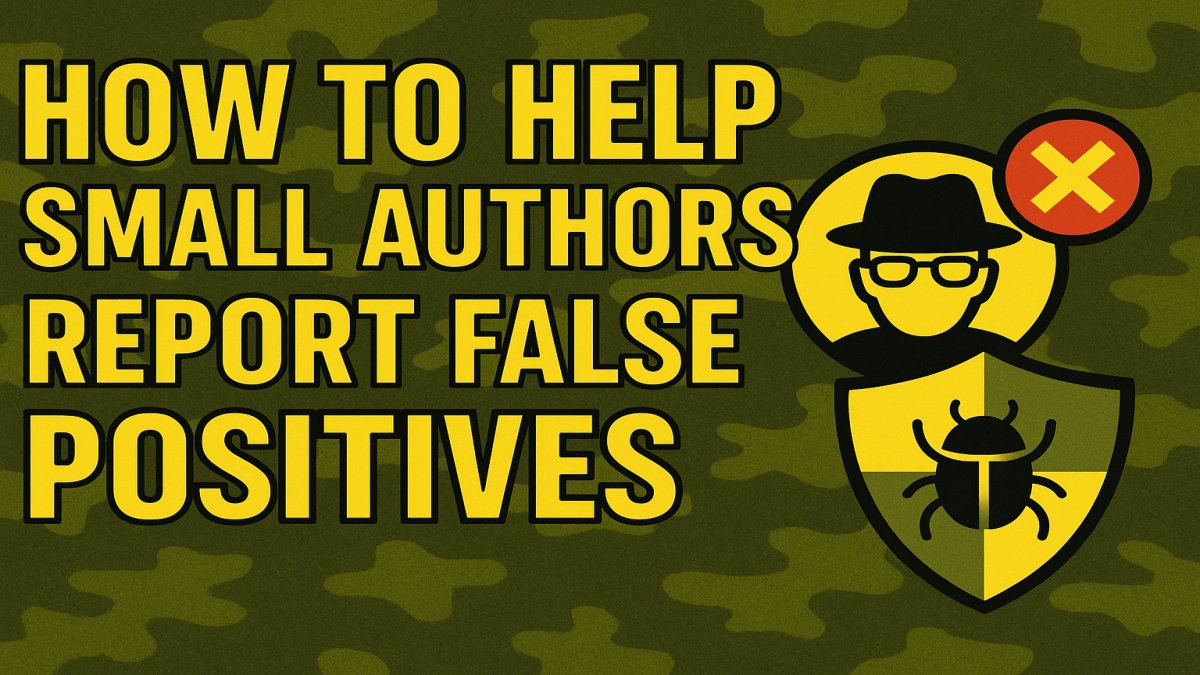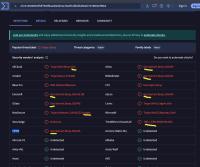How to Help Small Developers Report False Positives
By Corporal Punishmenton 11/10/2025 |
 Small software authors often build tools large companies overlook: registry fixers, portable utilities, repair helpers, script-based launchers, and niche solutions created by those who rely on them daily. Antivirus software often fails to identify new files, flagging them with generic warnings like Trojan.Generic or Gen.Trojan. These alerts typically do not indicate malicious intent; rather, they reflect unfamiliarity.
Small software authors often build tools large companies overlook: registry fixers, portable utilities, repair helpers, script-based launchers, and niche solutions created by those who rely on them daily. Antivirus software often fails to identify new files, flagging them with generic warnings like Trojan.Generic or Gen.Trojan. These alerts typically do not indicate malicious intent; rather, they reflect unfamiliarity.This poses a significant obstacle, specifically for small developers. Antivirus engines rely on reputation scores and user history to establish trust. Major companies possess extensive track records, expensive code signing certificates, and recognizable publisher identities. Smaller developers and open-source developers have none of these advantages, putting them at a significant trust deficit.
Why Generic Detections Happen
Antivirus programs apply heuristic and behavior-based detection. If a file is new, mimics behaviors linked to malware, or simply appears unfamiliar, it may be flagged. These generic names signal suspicion, not confirmation. They indicate ambiguity.
Another problem is when a developer uses an open-source library for something completely harmless, for example, retrieving an IP address. If a real piece of malware in the past had used that same library, antivirus engines might lump them together. Now, you have a brand new program that does nothing malicious, but it gets flagged simply because it shares a common component with something bad. The code is not dangerous. It is just guilty by association.
With the rise of machine learning based protection, the false positive problem is actually getting worse. Think of it like the automated phone system that answers when you call a company and just want to talk to a real person. Now imagine that same confused script is the one deciding whether your program is a virus. That is essentially what is happening with many antivirus systems today.
Some common examples you may see in a report:
● Trojan.Generic
● Gen:Variant.SomeName
● Suspicious.Cloud
● Heur.MachineLearning.Score
These terms (typically indicated by GEN for generic) reveal only that the antivirus is uncertain. For users, warnings remain alarming, which can quickly erode a developer’s credibility.
Here is a screeshot of a great example of a false positive on a sweet little open source image viewer called Pillow View. It shows not only that many of the companies use the same data but a quick google on Gen:Variant.Barys.502445 shows it as a know false positive. Yet the author is brutally punished.

Why This Matters
Independent developers often lack access to budgets, time and legal resources. Many distribute software for free or publish it as open source. A false positive can damage their reputation, even with clean software. Every flagged file decreases user numbers and visibility, fueling a difficult-to-break cycle.
The best solution we have now is to report the false positive to the reporting antiviral company so they can manually review the file and clean it up. Reporting false positives helps both the developer and the community.
What Users Can Do to Help
If you use a small developer’s software and see a generic warning, you can make a real difference simply by reporting it. Many developers work alone, often in their free time, and they may not have the resources to submit multiple reports across every antivirus company. When you submit a false positive report yourself, it counts as another confirmation that the program is safe. Antivirus companies take user reports seriously because they show that real people are using the tool. You do not need technical skill to help. Report the detection to the vendor, including the software name, a link to the download page, and a brief note stating that the software is safe. One minute of effort can help keep good freeware alive and stop independent authors from giving up on their projects.
Where to Report False Positives
Some antivirus programs make it easier than others to correct a false positive. For example, Microsoft Defender allows you to review items in quarantine and choose to restore them, and Avast includes a button to submit a quarantined file for re-analysis. Other antivirus tools offer similar options inside their quarantine or security history screens. However, even if the program itself does not provide a direct “submit as safe” button, every major antivirus company provides a website or portal where you can upload the file for review and request that the detection be corrected
If you really want to dig in. The first thing we do here at MajorGeeks with a new submission is to scan a file at VirusTotal. VirusTotal does not determine whether software is safe. It only shows vendor scan results, but it also shows almost all the vendor results, and there are a lot of them. Then if we see something clearly false positive, we try to help the author out with submissions.
Below is a list of direct submission pages where you can report incorrect detections for the major players. When reporting, include the executable or ZIP file, the project website, and optionally a VirusTotal link so the vendor can verify. Note: Some may require an account.
False Positive Submission Links
Microsoft Defender / SmartScreen https://www.microsoft.com/en-us/wdsi/filesubmission
Avast / AVG https://www.avast.com/false-positive-file-form.php
Bitdefender https://www.bitdefender.com/en-us/business/submit
ESET / NOD32 https://www.eset.com/int/support/submit-sample/
Kaspersky https://opentip.kaspersky.com/
F-Secure https://www.f-secure.com/us-en/support/submit-a-sample
Malwarebytes https://forums.malwarebytes.com/forum/122-false-positives/
Sophos https://support.sophos.com/support/s/article/KB-000036881
Trend Micro https://success.trendmicro.com/en-US/solution/KA-0008383
Vipre https://helpdesk.vipre.com/hc/en-us/requests/new
McAfee https://www.mcafee.com/support/s/article/000001921?language=en_US
If need be, you can google the smaller suys or VirusToal keeps and email list here: https://docs.virustotal.com/docs/false-positive-contacts
Final Thoughts
The antivirus world didn’t set out to hammer small developers, but that is exactly what is happening. Their trust systems are built around age, volume, best guess and paid code-signing certificates. Big companies have all that. New indie devs do not. So the system sees “new file from unknown author” and jumps straight to “better safe than sorry,” even when the software is perfectly clean.
This is where regular users can make a real difference. Like they say, if you see somethin — say something. If you like a tool and you know it’s legit or try something and see the dreaded “GEN.” prefix, take a minute to report the false positive. That single report can restore trust, keep the project alive, and help preserve the freeware spirit that made the internet awesome in the first place. A few clicks goes a long way.
comments powered by Disqus






